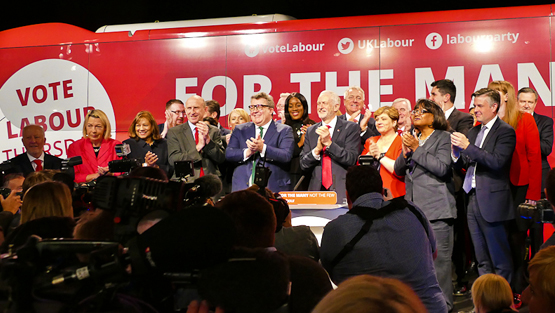Review of a book arguing that it is ideas that matter to the Labor Party - not the people selling them.

The Labour Party is currently undergoing a period of transition. With the election of Keir Starmer, the era of Jeremy Corbyn appears to be over. How much of a legacy it will have on Labour and British politics, in general, has yet to be seen. However, books are already being written and published which attempt to place Corbyn and Corbynism into context with the rest of Labour’s history. One such work is Dimitri Batrouni’s excellent The Battle of Ideas in Labour: From Attlee to Corbyn and Brexit.
The book is divided into four historical periods – Labour from 1945 – 1992, New Labour, Ed Miliband’s time as leader and Jeremy Corbyn’s time as leader. As Batrouni states, to understand the appeal of Corbynism inside the Labour Party it is important to not only understand the philosophies that went before it but also “how they tried to adjust to their political environments.” Whilst some may question the lumping together of the period of 1945 – 1992 which can be argued to be too broad and feature too many shifts to necessarily be classed as one era of thought, Batrouni correctly argues that there is a stronger relationship between the development of ideas and the internal battles over them than in later periods.
Batrouni’s work successfully endeavours to investigate how ideas are central to the internal narrative of the Labour Party and also how ideas interact and coalesce into a distinct political philosophy. Batrouni does well to break down theories into tiers as he makes clear to define what an idea is and what distinguishes it from another type of notion.
The top tier is of overarching philosophical approaches such as socialism; the next is of programmatic ideas such as neoliberalism or Keynesian and finally the Policy Idea, such as tax credits or income tax. By utilising this taxonomy, Batrouni cleverly imposes a structure on how to classify an idea but also examines how theories are interlinked and spawn other ideas. It demonstrates effortlessly how ideological imperatives inform policy decisions.
Of course, much of the focus on ideas in the book is related to economic concepts, this is one of the central dividing lines in the Labour Party between various factions. Batrouni does well to highlight, for example, not just the liberal origins of the Keynesian economic outlook of the Attlee years but also Ed Miliband’s attempts to strike a balance between the different economic strands of the party represented by the New Labour government that preceded him and Corbyn’s more overtly left wing leadership that succeeded him.
Batrouni’s analysis is clear and concise in this way – he does not seek to score ideological points but rather examine how a political party can go from supporting the ideas of Tony Blair to supporting those of Jeremy Corbyn in a relatively short period. As with any work of historical investigation, the personalities of the central protagonists are impossible to erase but Batrouni keeps a tight focus on the ideas that drove the party as well as the different methods that created and disseminated those theories.
This allows Batrouni not only to demonstrate why Corbynism was appealing to many in the Labour Party but how it attempted to define itself in relation to the ideas of the past. This was not simply against the notions that lay behind New Labour but also the way that New Labour operated in relation to ideas; for an idea to influence party policy it had to “influence Blair personally, or the people close to him”. Corbyn’s aim to democratise the party and work towards ideas coming from the membership and forming was seen as refreshing by many. Batrouni is clear however that as in the days of Blair, the theories that dominated Corbynism came from those around the leader, in particular John McDonnell. Batrouni, therefore, not only demonstrates that the battle for ideas is a substantive one in the Labour Party but that the battle of perception is just as important; where ideas are seen to have come from is as important as the idea itself.
This highlights a fascinating and often overlooked facet of Labour’s seemingly continual internal struggles – that the connection between ideas and their perception informs the character of a leader. Blair’s desire to rid Labour of Clause IV was by no means radical but it cemented his image as a moderniser, focussed on Labour’s electability; similarly, Corbyn’s vote against the Conservative Government’s Welfare Bill during the 2015 leadership election ensured his status as an anti-austerity rebel, concerned with people rather than the “establishment.”
Dimitri Batrouni’s Battle of Ideas is an important and fascinating insight into the world not only of Labour’s internal politics but also of the ideas that generate it. It well worth reading for anyone interested in Labour’s extensive history and may be of particular use to its new leader, a man who needs to ensure he can deal with ideas successfully and ensure that the Labour Party accepts his.
Will Barber Taylor is a writer and Labour member.
Left Foot Forward doesn't have the backing of big business or billionaires. We rely on the kind and generous support of ordinary people like you.
You can support hard-hitting journalism that holds the right to account, provides a forum for debate among progressives, and covers the stories the rest of the media ignore. Donate today.



